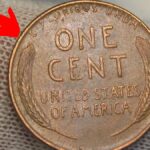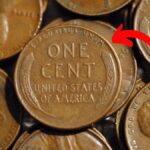Coins often carry more value than just their face value, with some becoming rare and highly sought-after collectibles. One such coin is the Lincoln Wheat Penny, which, despite being a regular part of currency for many years, has gained significant value due to its rarity and historical significance. In an astonishing turn of events, one specific Lincoln Wheat Penny is now valued at a staggering $1.1 billion. This article delves into the story behind this extraordinary penny, its current value, and how it continues to be a part of circulation.
What is the Lincoln Wheat Penny?
The Lincoln Wheat Penny was first introduced in 1909 by the U.S. Mint to commemorate the 100th anniversary of President Abraham Lincoln’s birth. Designed by artist Victor David Brenner, the coin featured a portrait of Lincoln on the obverse (front) side, and two stalks of wheat on the reverse (back), which is how it earned the name “Wheat Penny.” These pennies were minted from 1909 to 1958, and they were replaced by the Lincoln Memorial Penny after that.
Despite being a regular part of currency for several decades, many Lincoln Wheat Pennies have become rare collectibles due to specific minting errors, historical significance, and demand from coin collectors. One of these rare coins has been valued at an eye-popping $1.1 billion, making it one of the most valuable coins in the world.
Why Is the Lincoln Wheat Penny Valued at $1.1 Billion?
While most Lincoln Wheat Pennies are worth only a few cents, some of the rarest versions have been sold for millions of dollars at auctions. The $1.1 billion valuation refers to one particular penny that stands out for its unique history and features.
This penny is a rare variant of the 1943 copper Wheat Penny, a coin that was originally minted in error. During World War II, the U.S. Mint faced a shortage of copper and switched to producing pennies from zinc-coated steel. However, a small number of these pennies were accidentally struck using copper planchets, making them an incredibly rare mistake. These copper pennies are highly coveted by collectors, with one of them being sold for a record-breaking price.
In fact, the 1943 copper penny is so rare that only a handful of them are known to exist. The specific penny that is valued at $1.1 billion is considered to be the most significant of its kind, making it one of the most valuable coins in numismatic history.
The 1943 Copper Penny: The Coin That Changed Everything
The 1943 copper Wheat Penny is the key to understanding the $1.1 billion valuation. During World War II, the U.S. Mint made the decision to switch to zinc-coated steel pennies in order to conserve copper for the war effort. However, due to a mistake in the minting process, a small batch of pennies was struck with copper planchets instead of steel. These copper pennies were distributed alongside the regular steel pennies, and for many years, they went unnoticed.
It wasn’t until the late 1940s that collectors and dealers started to notice the rare copper pennies and began to realize their value. As the demand for these rare coins grew, their prices skyrocketed, and the 1943 copper penny became one of the most sought-after coins in the world. In fact, the specific penny valued at $1.1 billion is the most famous of all the 1943 copper pennies, making it an incredibly prized possession for collectors.
How Did the Penny Reach $1.1 Billion?
The value of this particular 1943 copper penny grew over time due to its extreme rarity and historical significance. Initially, the copper pennies were not recognized as valuable, and they circulated just like any other coin. However, as more collectors and numismatists (coin experts) began to notice the error, the penny’s worth increased dramatically.
In recent years, the penny’s value has continued to climb, driven by the growing interest in rare and valuable coins. The $1.1 billion valuation is a result of several factors, including the coin’s rarity, its historical context, and the high demand from collectors. The penny has become a symbol of the intersection between history and error, and it remains a highly sought-after treasure in the numismatic world.
How Can You Spot a Rare 1943 Copper Penny?
If you happen to come across a 1943 penny and think it might be a copper version, there are a few things you can check to confirm its authenticity:
- Date and Mintmark: The coin should be from 1943. Check for a mintmark (such as “D” for Denver or “S” for San Francisco) or no mintmark for coins struck at the Philadelphia Mint.
- Weight: A standard 1943 steel penny weighs about 2.7 grams, while a copper penny weighs around 3.1 grams. If you have a penny from 1943 that weighs more than the usual steel version, it could be a copper penny.
- Color: Copper pennies are reddish-brown, while steel pennies are silvery in color. Over time, a copper penny might tarnish and lose its bright red hue, but its color will still differ from that of a steel penny.
It’s important to remember that there are many counterfeit or altered coins in circulation, so it’s crucial to have any suspected rare pennies verified by a professional numismatist.
The Role of Coin Collectors and the Coin Market
The coin market has been growing in recent years, with rare and valuable coins attracting attention from collectors, investors, and numismatists. The discovery of rare coins, such as the 1943 copper penny, often leads to fierce bidding at auctions, with prices reaching astronomical figures.
For collectors, finding a rare coin can be just as thrilling as the financial reward. The excitement of searching for elusive coins has turned coin collecting into a global hobby. Some collectors specialize in finding coins with minting errors or other rare characteristics, such as the 1943 copper penny.
Are There Other Rare Lincoln Wheat Pennies?
While the 1943 copper penny is the most famous and valuable, there are other rare Lincoln Wheat Pennies worth noting. Some notable examples include:
- 1909-S VDB Penny: This penny features the initials “VDB” for the designer, Victor David Brenner, and was minted in San Francisco.
- 1922 No D Penny: This penny was struck without the “D” mintmark, making it a rare and collectible find.
- 1955 Double Die Penny: This penny features a noticeable doubling of the date and inscriptions due to a minting error.
While these coins are valuable, none come close to the staggering $1.1 billion value of the 1943 copper penny.
Conclusion: A Coin That Continues to Fascinate
The Lincoln Wheat Penny, especially the rare 1943 copper version, is a remarkable coin with a rich history and immense value. Despite its humble beginnings as a regular part of currency, it has become one of the most sought-after collectibles in the world. The $1.1 billion valuation of the 1943 copper penny highlights the fascinating intersection of history, error, and value in the world of coin collecting. While most Lincoln Wheat Pennies are still in circulation, the rare ones continue to captivate collectors and investors, making the pursuit of rare coins an exciting and ever-growing hobby.
Disclaimer: The information provided in this article is for educational purposes only. Coin values may fluctuate, and any claims regarding the rarity or worth of specific coins should be verified by a professional numismatist.






